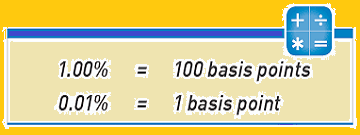
Basis points (BPS), sometimes referred to as “Bips” are one hundredths (1/100ths) of a percent. That is, one basis point, or bip is equivalent to 0.0001 in decimal form or 0.01%. This terminology is used primarily by traders in the debt markets to describe the rate of change in bond yields or the interest rate of certain financial instruments.
The use of “bips” in debt market terminology simplifies the descriptions and removes ambiguity in conversation for the following reasons
- Accurately describes to level of change in interest rate changes and debt securities
- Avoids ambiguity when discussing the relative or absolute change in interest rates. For example, if an interest rate has moved from 9% to 10%, traders in some markets may describe the change as 1% increase in the interest rate. Thus using the absolute method. However, traders in a different market may claim a (10% – 9%) / 9% = 11.11% movement referring to the increase in the interest rate in relative terms. If the relative change was applied as an absolute change, traders may incorrectly calculate a new value of 9% + 11.11% = 20.11%. Basis points removes the ambiguity by referring to the change as an increase of 100 bips.
This is further explained in the example below.
A Real Life Basis Points (BPS) Example
In response to the COVID-19 pandemic, on March 15, 2020 the Federal Open Markets Committee (FOMC) reduced the target federal funds rate to a range of 0 – 0.25%. The previous level was 1.00 – 1.25%. Therefore the decrease can be written as
- 1% decrease – absolute change
- (0.125 – 1.125) / 1.125 = 88.89% relative value change
- A decrease of 100 basis points (bps, bips)
In addition to usage by the FOMC, in the bond market should the yield on a bond rise from 5.25% to 5.50%, traders will say the yield has risen 25 basis points. The usage of basis points can also be applied to a range of additional financial instruments. Some of the more well known examples are listed below
- Corporate bonds (including convertible bonds)
- Credit derivatives
- Equity (common stock)
- Debt securities (mortgages, pmi)
- Interest rate derivatives
- Municipal bonds
- Treasury bonds
Conversion Examples
The above examples demonstrates how the use of basis points (bps) can eliminate ambiguity. This universal unit of measurement is both easy to understand and simple to implement. The following formula and table demonstrates how straightforward it is to convert bips into a percentage. Simply take the number of basis points and multiply by 0.0001.
In order to convert 123 basis points into percentage form, multiply 123 by 0.0001
123 x 0.0001 = 1.23%
| Basis Points | Percentage Terms |
|---|---|
| 1 | 0.01% |
| 10 | 0.1% |
| 50 | 0.5% |
| 100 | 1% |
| 1,000 | 10% |
| 10,000 | 100% |
